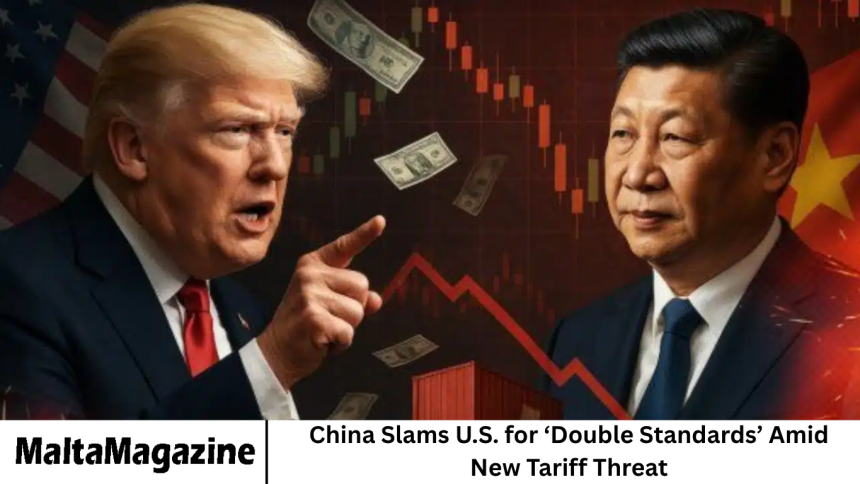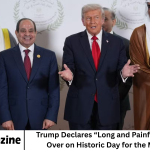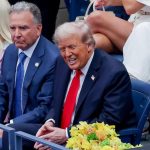The long-simmering trade tensions between the world’s two largest economies—China and the United States—have flared up once again. In the latest development, Beijing has strongly condemned Washington’s renewed threat to impose additional tariffs on Chinese goods, accusing the U.S. of practicing blatant “double standards.”
- A Familiar Flashpoint: The Return of Trade Frictions
- China’s Response: Firm Words and Calls for Dialogue
- The U.S. Position: Protecting Domestic Industries
- Global Reaction: Concern Over Economic Fallout
- Historical Context: The Shadow of the Trade War
- Economic Implications: The Cost of Confrontation
- Tech Tensions: The Semiconductor and EV Fronts
- Diplomatic Fallout and the Way Forward
- Frequently Asked Question
- Conclusion
This sharp rebuke came after senior U.S. officials hinted at a potential escalation of trade barriers against Chinese imports, citing alleged “unfair trade practices” and concerns about industrial overcapacity. The Chinese government, however, has called the move politically motivated.
Warning that such actions could destabilize the global economy and worsen inflationary pressures worldwide. The dispute has reopened old wounds from the trade war years under former President Donald Trump and threatens to derail the fragile economic recovery many nations are currently depending on.
More Read: UK Firms and Charities Warn Nuclear Levy May Spike Bills
A Familiar Flashpoint: The Return of Trade Frictions
The U.S.-China trade conflict, which first erupted in 2018, was thought to have cooled after years of tit-for-tat tariffs that disrupted global markets. However, recent statements from Washington suggest a potential revival of protectionist policies.
U.S. trade representatives have reportedly been reviewing China’s adherence to commitments made under the “Phase One” trade deal signed in January 2020. The Biden administration, and now potentially the upcoming presidential frontrunners, have both expressed concerns.
About China’s industrial subsidies, alleged intellectual property violations, and dominance in key sectors like electric vehicles (EVs), steel, and solar technology. China, in turn, sees these new threats as a continuation of what it calls “economic containment.”
Officials from Beijing’s Ministry of Commerce (MOFCOM) accused Washington of “weaponizing trade” under the guise of protecting American jobs. In a fiery statement, the ministry said, “The United States preaches free trade when it benefits itself but resorts to unilateralism when others make progress.
This is the very definition of double standards.”
China’s Response: Firm Words and Calls for Dialogue
Beijing’s response has been measured but firm. The Chinese government has stated that while it does not seek confrontation, it will “take all necessary steps” to safeguard its national interests.
At a press conference, Chinese Foreign Ministry spokesperson Lin Jian said, “China will not be intimidated by tariff threats. We urge the U.S. to correct its mistakes, stop politicizing trade, and create a fair and stable environment for global cooperation.”
China has also appealed to international institutions such as the World Trade Organization (WTO), arguing that the U.S. tariffs violate multilateral trade rules. According to Chinese analysts, the move undermines the credibility of the U.S. as a global leader promoting free markets.
Several economic think tanks in Beijing have warned that retaliatory tariffs or restrictions on U.S. exports—especially in the agricultural and technology sectors—could follow if Washington proceeds with its plans.
The U.S. Position: Protecting Domestic Industries
From Washington’s perspective, the new tariff threats are framed as a necessary measure to ensure “economic fairness.” U.S. officials argue that China’s aggressive industrial policy, massive state subsidies, and overproduction in sectors like green energy and steel are distorting global markets.
Treasury Secretary Janet Yellen recently stated that China’s “industrial overcapacity” poses a serious threat to manufacturing industries not just in the U.S. but across the world. “When Chinese companies flood the market with cheap goods supported by subsidies, it undercuts fair competition.
And threatens American workers,” Yellen said. Additionally, the U.S. government has emphasized national security concerns, particularly in industries such as semiconductors, telecommunications, and renewable energy technology.
Washington continues to restrict exports of advanced chips and manufacturing equipment to Chinese firms, citing risks of dual-use technologies being repurposed for military applications. However, critics argue that the U.S. approach risks backfiring by increasing consumer prices and alienating key trade partners who depend on stable U.S.-China economic relations.
Global Reaction: Concern Over Economic Fallout
The international community has reacted with growing concern. Global markets, already jittery over slowdowns in Europe and inflationary pressures in the U.S., are bracing for renewed instability.
Economists warn that an escalation between Washington and Beijing could rattle supply chains, particularly in critical sectors such as electronics, electric vehicles, and green energy components. European leaders, many of whom have sought to maintain a delicate balance between the two giants, have called for restraint.
The European Union’s trade commissioner, Valdis Dombrovskis, commented that “protectionism benefits no one in the long run.” He urged both sides to “resolve differences through dialogue rather than tariffs.”
Emerging economies are particularly worried about the spillover effects. Many developing nations rely heavily on both U.S. and Chinese demand for exports and fear that a new round of tariffs could slow down global trade growth.
Historical Context: The Shadow of the Trade War
The 2018–2020 U.S.-China trade war set a precedent that continues to shape current relations. Under the Trump administration, the U.S. imposed tariffs on more than $360 billion worth of Chinese goods, while Beijing retaliated with levies on $110 billion of U.S. exports.
Though the Phase One deal brought a temporary truce, it failed to resolve deeper structural issues. Many U.S. industries complained that China did not meet all its purchasing commitments, while Beijing accused Washington of maintaining restrictions inconsistent with the agreement.
When President Joe Biden took office, there was cautious optimism that relations might stabilize. Instead, the Biden administration largely retained Trump-era tariffs while expanding controls over technology exports and investment restrictions.
Now, with upcoming elections in the U.S. and China facing slower growth at home, both governments are under pressure to project strength—potentially reigniting economic confrontation.
Economic Implications: The Cost of Confrontation
The potential consequences of a renewed tariff war are enormous. Analysts estimate that new tariffs could affect billions of dollars in trade, raising prices for American consumers and squeezing profit margins for manufacturers reliant on Chinese supply chains.
For China, the impact could be equally significant. Its export-driven economy remains vulnerable to trade barriers, particularly at a time when domestic demand is soft and the property sector is under strain.
The International Monetary Fund (IMF) has cautioned that trade fragmentation could reduce global GDP by up to 7% over the long term—a figure equivalent to the entire economy of France.
Investors, too, are uneasy. Stock markets in Asia have shown volatility amid fears of another trade confrontation, while the Chinese yuan has weakened slightly against the U.S. dollar in response to the rhetoric.
Tech Tensions: The Semiconductor and EV Fronts
Beyond tariffs, technology remains a major fault line in U.S.-China relations. Washington has been intensifying efforts to limit China’s access to advanced semiconductors and manufacturing tools, citing security risks.
Meanwhile, China has surged ahead in renewable energy and electric vehicle production—sectors that the U.S. claims are unfairly supported through massive subsidies. American officials argue that this “state-backed capitalism” distorts global markets and threatens U.S. green industry initiatives.
In response, Beijing accuses Washington of hypocrisy, noting that the U.S. itself offers large subsidies under the Inflation Reduction Act (IRA) to promote domestic manufacturing of clean technologies.
“When the U.S. subsidizes its own industries, it calls it green innovation. When China does the same, it’s labeled unfair competition,” remarked a Chinese economist on state broadcaster CCTV.
Diplomatic Fallout and the Way Forward
Diplomatic relations between Beijing and Washington have been under strain for years, strained further by disputes over Taiwan, cybersecurity, and human rights issues. The renewed trade confrontation adds another layer of complexity.
Despite the harsh words, some analysts believe both sides may still prefer negotiation over confrontation. Recent high-level dialogues—such as the visits of U.S. officials to Beijing and vice versa—indicate that communication channels remain open.
There is also a shared recognition of the risks: both economies are too intertwined to decouple easily. The U.S. relies on Chinese manufacturing for many consumer goods, while China remains one of America’s largest export markets.
However, political pressures in both capitals may make compromise difficult. With election season looming in the U.S., candidates are unlikely to appear soft on China. Conversely, Beijing faces domestic challenges that make yielding to U.S. pressure politically unpalatable.
Frequently Asked Question
What triggered China’s accusation of “double standards” against the U.S.?
China’s criticism came after the U.S. threatened new tariffs on Chinese imports, accusing Beijing of unfair trade practices and industrial overcapacity. China claims the U.S. is being hypocritical—promoting free trade while practicing protectionism when it suits American interests.
How could new tariffs affect global markets?
New tariffs could disrupt global supply chains, raise consumer prices, and dampen trade growth. Economists warn that a renewed trade war might destabilize financial markets and slow global economic recovery, especially in sectors like technology and green energy.
Has the U.S.-China trade war ever truly ended?
Not entirely. Although the 2020 “Phase One” deal eased tensions, many tariffs from the Trump era remain in place. The Biden administration continued most of those measures while expanding technology export restrictions, keeping trade relations strained.
Why does the U.S. accuse China of industrial overcapacity?
The U.S. argues that China’s government heavily subsidizes industries such as steel, solar panels, and electric vehicles, leading to overproduction and artificially low prices. This, Washington says, undermines competition and harms foreign manufacturers.
How has China responded to the U.S. threats?
China has condemned the U.S. actions as politically motivated and a violation of WTO principles. Beijing has warned of possible retaliatory measures and called on Washington to return to dialogue and cooperation instead of confrontation.
What are the possible long-term effects of renewed trade tensions?
Long-term consequences could include economic decoupling, higher costs for consumers, slower global growth, and reduced trust in multilateral institutions. Businesses may also accelerate efforts to diversify supply chains away from both the U.S. and China.
Is there hope for a resolution between the two countries?
Yes, though the path forward is uncertain. Both nations understand the risks of escalation and have maintained communication channels. If cooler heads prevail, renewed talks could lead to compromises on specific sectors or a revised trade framework that benefits both sides.
Conclusion
The latest U.S.-China tariff dispute highlights not just an economic rivalry but a deeper ideological divide over how global trade should function in the 21st century. China’s accusation of “double standards” underscores its frustration with what it perceives as U.S. hypocrisy.
The U.S., on the other hand, insists that its actions are necessary to level the playing field and safeguard its industries from unfair competition. Whether this new phase of tension leads to outright confrontation or cautious compromise will depend on how both nations balance domestic politics with global responsibility.








